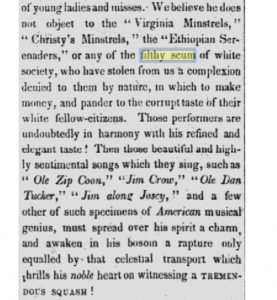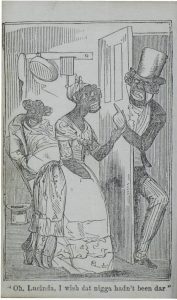If one were to ask what a minstrel show was in today’s world, many outside of the study of music would most likely not have a solid definition foundation, but go back more or less 150 years and you will find it to be a popular event. As blackface comedy, it un-Americanizes negro spirituals that were already being told they were copies and variations of European compositions with simplified notes and less melodic melody. One example is Richard Wallschek. He states, “these negro songs are very much overrated”. 1
When a group of people is secluded to a style of living in one place, they will adopt and adapt what they learn to what they already know, how does that make it not American or stealing?
However, these minstrel shows were not creating a new genre of music, they were genuinely stealing Afro-American Folksongs. Frederick Douglass had a strong viewpoint on minstrel performers with the newspaper clipping below from the North Star article on October 27th,1848:
As one can see, there is a strong standpoint on how white people used their status and race to take advantage of and degrade slaves as a way of entertainment. Even the way they dressed and drew pictures was a way to demean and make fun of as if slaves could not have their own music and own culture.
The Virginia Minstrels quickly capitalized on popularity by showing America the first real minstrel show involving a minstrel ensemble in 1843. One could say that minstrel shows were done to show how cruel and unjust slavery could be. Or that it became popular during a time when slavery was being debated as more detrimental than beneficial and whites became more curious about black people.4
Eric Lott, the author of “Love and Theft: Blackface Minstrelsy and the American Working Class”, talks about how maybe minstrels were essential to the making of the white working class because they brought to light the issues of not only race but also class and gender. He even goes on to say that blackface potentially regulated the formation of white working-class masculinity.5
This understanding of minstrel music, unfortunately, fortunately, can lead to a deeper understanding of race and slavery.
1 Henry Krehbiel, Afro-American Folksongs: A Study in Racial and National Music (1914), 11.
2 “The Hutchinson Family-Hunkerism.” Frederick Douglass’ Paper (Rochester, New York) I, no. 44, October 27, 1848: [2]. Readex: African American Newspapers. https://infoweb.newsbank.com/apps/readex/doc?p=EANAAA&docref=image/v2%3A11BE9340B7A005AB%40EANAAA-11D0A391B293AD78%402396328-11D0A391CBF9FAA0%401-11D0A39223979A50%40The%2BHutchinson%2BFamily-Hunkerism.
3Ryser, Tracey A. “‘A White Man’s Inadequate Portrait of a Slave’: Minstrel Shows and Huckleberry Finn”. Youngstown State University, August, 2004. https://digital.maag.ysu.edu/xmlui/bitstream/handle/1989/6342/b19594422.pdf?sequence=1&isAllowed=y
5Winans, Robert B. American Music 13, no. 1 (1995): 109. https://doi.org/10.2307/3052314.


